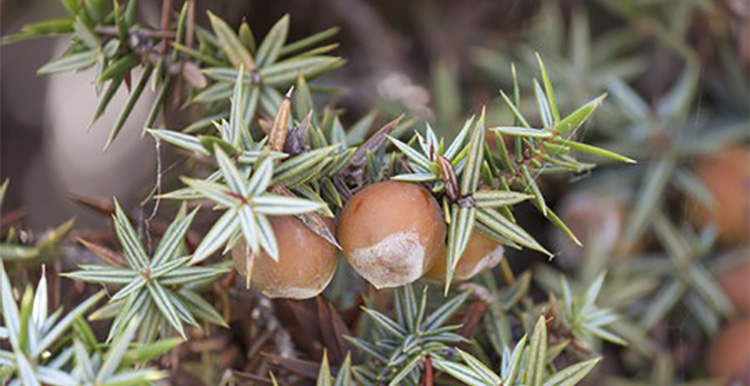Cade Essential Oil (Rectified)
Juniperus oxycedrus

Description
Cade, also known by several other common names including Juniper Tar and Prickly Juniper, is a variety of juniper that is native to regions of the Mediterranean.
Rectified Cade Essential Oil is generally obtained by steam distillation of the crude extraction of cade oil through destructive distillation. According to Tisserand and Young, crude (unrectified) Cade Oil is potentially carcinogenic due to the presence of benzo[a]pyrene and should not be used internally or externally. They precaution that only rectified Cade Oil should be used. [Robert Tisserand and Rodney Young, Essential Oil Safety (Second Edition. United Kingdom: Churchill Livingstone Elsevier, 2014), 222-223.] Therefore, it's important to ensure that you procure and use only Cade Oil that has been rectified to remove the carcinogenic constituents.

Unless you have an appropriate background in aromatherapy to understand the risks of working with the crude oil, I don't recommend procuring or working with it. Crude, unrectified Cade Oil is generally darker, thicker and smokier than is rectified Cade Essential Oil.
Aromatically, rectified Cade Oil possesses a deep, smoky, woody, somewhat tar-like aroma. I've also heard the term "leather" used to describe the aroma. Those that are fond of the aroma of Vetiver Essential Oil may also favor the aroma of Cade Essential Oil. It acts as a base note and can act as a fixative in fragrance blends.
Emotionally, Cade Oil is grounding and can promote a sense of calm. I can see it being useful in meditation and for the Root Chakra in Chakra applications.
Cade Essential Oil Benefits and Uses
- Cuts
- Dandruff
- Dermatitis
- Eczema
- Spots
Source: Julia Lawless, The Encyclopedia of Essential Oils (Updated Edition) (London: Harper Thorsons, 2014), 55-56.
Botanical Name
Plant Family
Common Method of Extraction of Rectified Cade Oil
Steam Distillation and Rectification of the Crude Oil
Plant Part Typically Used
Color
Generally Light to Medium Brown
Consistency
Medium-Thick
Perfumery Note
Base
Strength of Initial Aroma
Medium
Aromatic Description
Cade Essential Oil smells smoky. It is similar to the aroma of burning wood or tar.
Sustainability and Conservation Status
Least Concern
Source: https://www.iucnredlist.org/species/42243/2965838
To learn more about the conservation status of essential oil bearing plants and how to use the IUCN Red List of Threatened Species, please refer to AromaWeb's Guide to Essential Oils and Sustainability.
Major Constituents of Rectified Cade Oil
- delta-Cadinene
- Torreyol
- Epicubenol
- Zonarene
- B-Caryophyllene
See Essential Oil Safety for a more complete list of typical constituents.
Source: Private Communication: Abisset 2004. Source cited in Robert Tisserand and Rodney Young, Essential Oil Safety (Second Edition. United Kingdom: Churchill Livingstone Elsevier, 2014), 224.
Cade Essential Oil Safety Information of Rectified Cade Oil
Due to the presence of a carcinogen known as Benzo[a]pyrene in crude (unrectified) Cade Oil, only oil that has been rectified to remove the carcinogenic compound(s) should be used. Tisserand and Young caution that there is a risk of toxicity even with the rectified oil. Reading Tisserand and Young's full profile is recommended. [Robert Tisserand and Rodney Young, Essential Oil Safety (Second Edition. United Kingdom: Churchill Livingstone Elsevier, 2014), 222-223.]
General Safety Information
Do not take any oils internally and do not apply undiluted essential oils, absolutes, CO2s or other concentrated essences onto the skin without advanced essential oil knowledge or consultation from a qualified aromatherapy practitioner. For general dilution information, read AromaWeb's Guide to Diluting Essential Oils. If you are pregnant, epileptic, have liver damage, have cancer, or have any other medical problem, use oils only under the proper guidance of a qualified aromatherapy practitioner. Use extreme caution when using oils with children and be sure to first read the recommended dilution ratios for children. Consult a qualified aromatherapy practitioner before using oils with children, the elderly, if you have medical issues or are taking medications. Before using this or any essential oil, carefully read AromaWeb's Essential Oil Safety Information page. For in-depth information on oil safety issues, read Essential Oil Safety by Robert Tisserand and Rodney Young.
Shelf Life
Important Information About the Profiles
The essential oil information provided on AromaWeb is intended for basic educational purposes only. The references to safety information, test results, constituents and percentages is generalized information. Essential oils can vary greatly in composition. The data is not necessary complete and is not guaranteed to be accurate. The essential oil photos are intended to represent the typical and approximate color of each essential oil. However, essential oil composition and color can vary based on harvesting, distillation, age of the essential oil and other factors. Profiles for several CO2 Extracts and absolutes are included within the directory, and are denoted as such.
